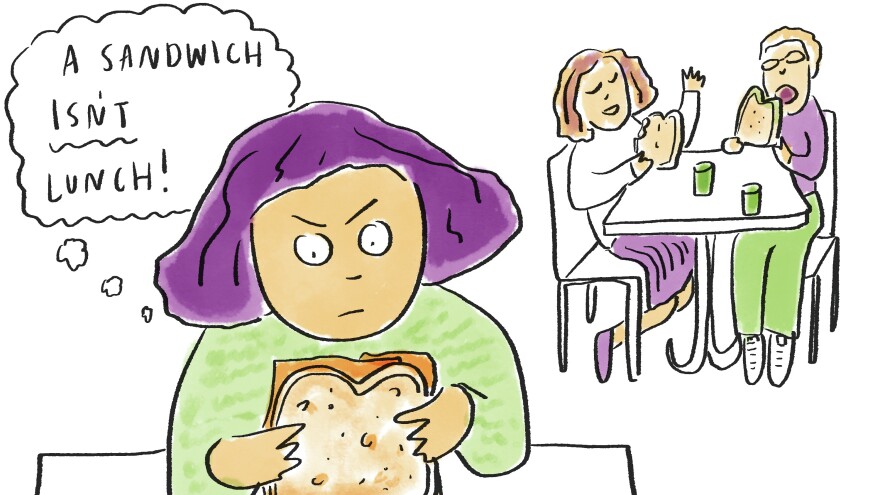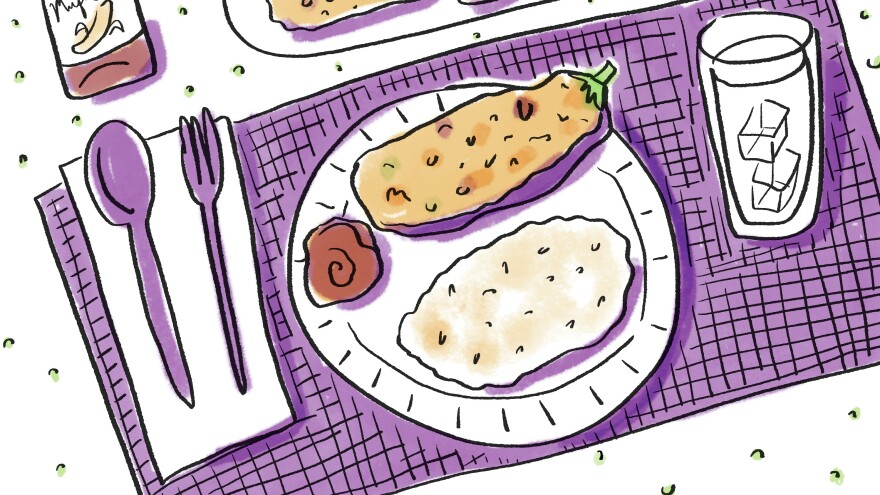The weekly potluck started simply enough. A new intern sent a Filipino-American colleague an email titled "Filipino intern looking to find other NPR Pinoys."
"He's looking for other Filipinos in the building to hang out with," my colleague told me, forwarding the email. "You should come to lunch with us."
I'm a Filipino-Egyptian-American. In my decade of working in Washington, D.C., I had never thought to reach out to my fellow kababayan, Tagalog for "countrymen," at the workplace for camaraderie and companionship — until this intern's very earnest request.
When we met the intern at the cafeteria, he told us that he had moved to D.C. from Southern California just a few weeks before. He didn't know many people. And he really, really missed Filipino food.
And that's how Kaibigan Klub was born. Kaibiganis Tagalog for friend.
About three months ago, a small group of NPR staffers of Filipino heritage began meeting in a fourth-floor kitchen for a weekly Pinoy potluck.
Toting our plastic containers of soups and stews and our spoons and forks — Filipinos traditionally don't use knives — we take turns microwaving our dishes, which we set at the center of the table to be eaten family style.

One week, I tried my hand at making apritada, a pork stew with potatoes, peas and peppers, flavored with fish sauce. I called my uncle, Tito Maro, to get the recipe. Another week, a colleague cooked sinigang, tender chunks of pork and veggies like eggplant and okra swimming in a sour tamarind broth.
There are always lots of sweets on the side, courtesy of care packages from our parents: jackfruit tarts wrapped in yellow cellophane, polvoron shortbread and candy made of ube, a shockingly purple yam.
And with it all, a giant Tupperware of steamed white rice to be eaten with every single bite of soup and stew.
At first, we cooked for the intern. He was the youngest in the group, the newest to the city. But then I realized that I haven't eaten this much Filipino food in years — since the last summer I spent home home from college back in 2008.
In short, I needed this just as much as he did.
Our potlucks quickly became a family affair. Second and third helpings are encouraged. It's fine to use your own spoon to grab more food. And if you want to eat kamayan-style, with your hands, to get a little more rice, a little more meat, that's OK, too.
The topic of conversation of course, was the food — and the memories it evoked. "Okra in sinigang?" I asked one colleague, flabbergasted. "We don't do that in our family. But this is good, though."

We talked about the ginger in the arroz caldo, a chicken porridge dish that another colleague brought in.
"When I was a kid, I used to tell my mom not to put ginger in it," one Pinoy visual editor said.
"But that's the best part!" a Filipina colleague countered.
The intern baked leche flan, a Filipino custard dessert. "I'm having problems caramelizing the sugar at the bottom," he said, pointing to the signature crust of molten sugar that tops the flan when flipped onto a plate. "I need that special oval pan that my mom uses, the one with the thin top and sides so you can melt the sugar over the stovetop."
"I have one!" I said. "My mom sent me one. I'll bring it in for you."
A decade ago, I was in that intern's shoes. Like him, I left Southern California — and my Filipino-American family and friends — for an internship in D.C. I rarely got to savor the Filipino foods that reminded me of home. Specialty ingredients like salted red egg or coconut vinegar were — and still are — hard to find in D.C. And Filipino cuisine is notoriously labor intensive. It often requires multiple garnishes, sauces and cooking techniques. Arroz caldo, for example, takes forever to cook, and comes with several garnishes including finely chopped scallions, chopped boiled eggs, lemon wedges, fried minced garlic and dribbles of fish sauce.
If I missed Filipino food, I had to wait until my next trip back to California. Or attempt to make it myself. But I never would have thought to reach out to my Filipino colleagues.

Part of it was because I had never worked with any. Before I was at NPR, I worked for small companies with few people of color. The other part of it was that I was afraid of letting the ethnic side of me show at the office. To be professional, to be taken seriously, my family had always told me I should try to blend in with the predominant white culture.
To me, that intern's email was a signal that things were changing. He is part of the latest cohort of first-generation Filipino-Americans who grew up with celebrities of Filipino heritage in mainstream media, like singer Bruno Mars, rapper Ruby Ibarra and comedian Jo Koy. They're proud of their ethnic heritage, they know who they are and they want to stay connected with their culture. Not just in their personal lives, but in their professional lives, too.
We end each potluck by brainstorming the next week's menu. For weeks, I've wanted to bring in rellenong talong — eggplant stuffed with meat, dipped in egg and fried. But it's difficult to make. The filling has ground pork, potatoes, raisins, carrots, peas, onions and peppers. I have to mince all the ingredients into uniform pieces and fry the potatoes separately. The eggplant must be grilled, peeled and mashed gently into a fan shape. And then somehow, using deft hands and a hot pan, I must add the filling while using beaten eggs to form the eggplant into a self-contained omelet shape.
My mother used to make this dish at home all the time. It was a weeknight dish. I remember eating it for dinner as a kid, on top of a giant mound of white rice and big dollop of neon red banana ketchup. To me, it was the ultimate comfort food.
I have cooked it on my own only once before, two years ago, for a dinner party. I needed a motivation to make such a complicated dish.

Now I had a new reason to make rellenong talong — and in some ways, a better reason. I would be making this for my kababayan, for people with the same food memories, the same cravings, the same emotional response when presented with a soft roll of pan de sal (sweet bread.)
I wish I had been brave enough or had the opportunity to send an email like that intern's sooner in my career. It would have made a difference to know that there was a familiar face, a kaibigan, at the office who I could turn to for support.
Or even just to share a Tupperware of rice.
Copyright 2020 NPR. To see more, visit https://www.npr.org.



